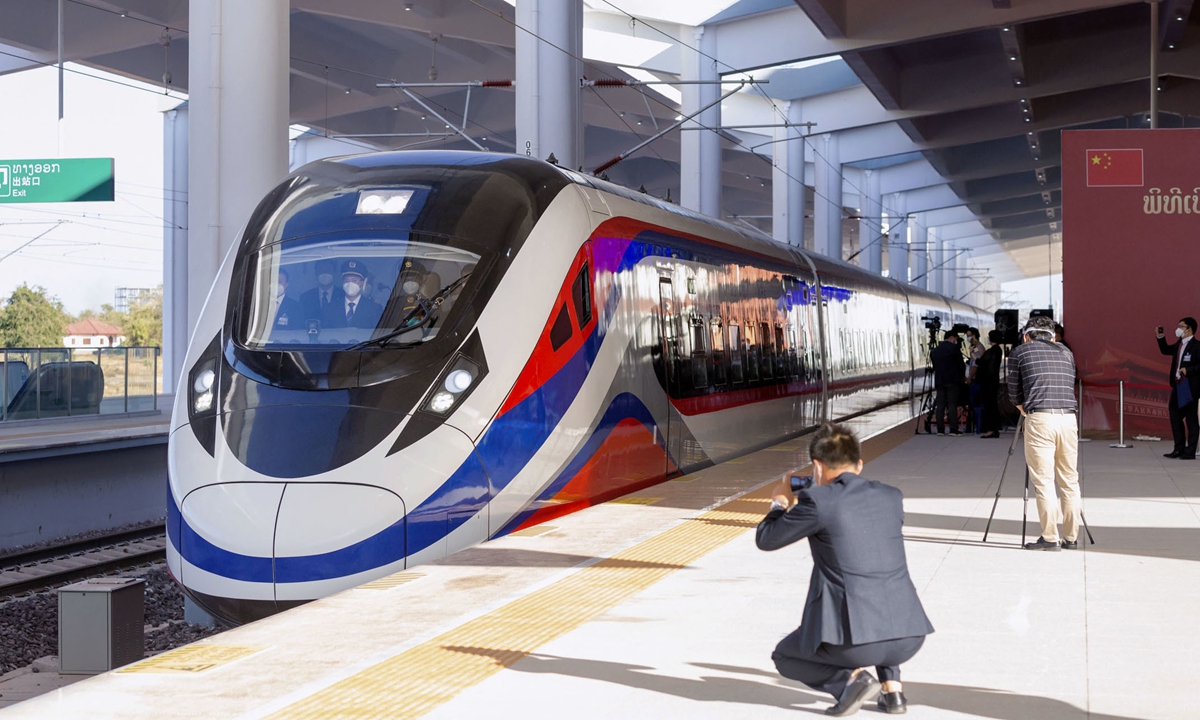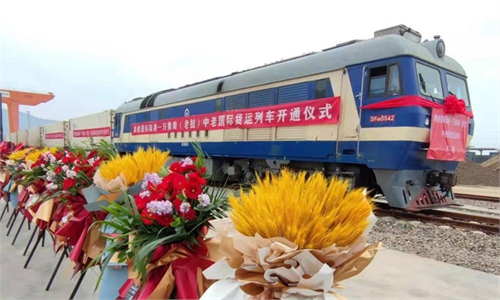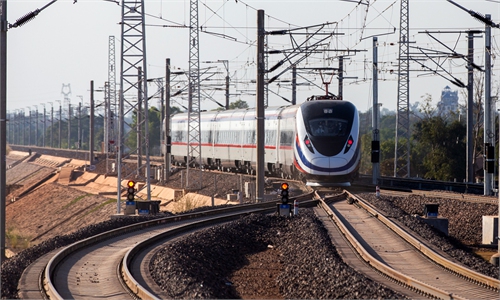Chinese cities rush to provide trains to China-Laos rail ahead of RCEP, a boon to SE Asia economy

The first international cargo train along the 1,035-kilometer China-Laos Railway arrives in Vientiane, Laos, on December 4, 2021. The signature project, under the China-proposed Belt and Road Initiative, officially went into full operation on December 3. Photo: VCG
Following the opening of the China-Laos Railway, a growing number of cities in China immediately rolled out freight trains to Lao capital Vientiane, providing well-timed transport convenience for the Regional Comprehensive Economic Partnership (RCEP) pact which will be implemented within a month, while countries in Southeast Asia are sparing no efforts to boost their economies as the Omicron variant of the coronavirus is threatening to upend the region's COVID-19 recovery.
There are high expectations that the China-Laos Railway, which was launched on Friday, a landmark project under China-proposed Belt and Road Initiative (BRI) linking Kunming of Southwest China's Yunnan Province with Vientiane, will drive trade and investment between China and Southeast Asia and promote cooperation in the Lancang-Mekong region in a flourishing era of bilateral relations, officials said.
Following the railway's launch, Chinese cities ranging from Southwest China's Chongqing and Chengdu to South China's Shenzhen opened freight trains to Laos, with many initiating the routes for the first time and shortening the transport time by half compared to sea transport.
Freight trains from Nanjing in East China's Jiangsu Province on Monday headed to Vientiane, Jiangsu International Freight Train Company told the Global Times.
This was followed by the departure of a train involved in cold-chain logistics on the China-Laos Railway, loading 33 containers of vegetables from Kunming on Saturday and expected to arrive in Vientiane on Sunday, the Xinhua News Agency reported on Sunday. The train would return with specialty products from Thailand and Laos to Kunming, which will be delivered to China's metropolitan cities of Beijing, Shanghai and Guangzhou, achieving closed-loop cold-chain transportation.
Such a blockbuster railway project was launched in the year which marked the 30th anniversary of ASEAN-China dialogue relations, a leading official of the ASEAN-China Center, an inter-governmental organization co-founded by 10 ASEAN member states and China, noted.
"The ASEAN-China Connectivity through the Kunming-Vientiane Rail Link will play an important role in strengthening ASEAN-China cooperation and people-to-people exchanges. The project also shows the implementation of the integration between the Master Plan on ASEAN Connectivity 2025 and the Belt and Road Initiative," the official told the Global Times on Monday.
The 1,035 kilometer-long route is expected to ultimately snake down through Thailand and Malaysia to Singapore, making the high-speed rail dream connecting Southeast Asia and China come true.
The railway will not only help Laos expand trade and attract investment, catapulting the landlocked Southeast Asian nation into a land-linked hub, but also facilitate regional countries to seize opportunities fueled by the world's largest trade deal as the RCEP will take effect starting January 1, 2022, Xu Ningning, executive president of the China-ASEAN Business Council, told the Global Times on Monday.
"Once the RCEP takes effect, the institutional arrangements in the region's open market will need the support of transport. Rules in the open market plus hardware infrastructure, like the China-Laos Railway, will power the region's economic growth," Xu said, stressing if the China-Laos Railway connects with other rail links, there will be a bigger and more open market for China and ASEAN members as the two sides will work to launch the Version 3.0 of the China-ASEAN Free Trade Area.
Looking forward, Xu said that ASEAN will be China's largest trade partner as long as tariff and trade barriers imposed by other major economies remain.
China-ASEAN trade grew from $8.36 billion in 1991 to $685.28 billion in 2020, with an annual growth of 16.5 percent, Chinese Customs data revealed.
Rail link with Thailand urged
The China-Laos Railway sparked hopes for better regional connectivity, and a connection with the Thailand-China High Speed Rail, which is currently under construction, will speed up the process.
Durian growers in Thailand, for instance, are looking forward to upgraded access to the lucrative Chinese market where Chinese consumers' appetite for Thai durian continues to rise.
Even if the China-Laos Railway is not yet ready to transport fresh fruit, and the durian season has not yet begun in Thailand, the Thai Durian Association expects the China-Laos Railway to be the main transportation route if prices and the process are competitive.
"We are pleading with the government to push forward the rail link with the China-Laos Railway because durian is critical to Thailand's economy," the association told the Global Times in a statement on Monday.
It now takes at least three days by truck and seven days by ship to transport durian from Thailand to China. "If the delivery time by train is faster and less expensive, that would be beneficial to both the exporter and importer, and would provide the highest quality of durian to the customer," the association added.
A director of the China Fruit Marketing Association surnamed Ti told the Global Times that the China-Laos Railway is bound to greatly promote the fruit trade in Southeast Asia.
For example, the export of tropical fruits - durian and longan--to China will increase, as the cost of fruit transportation will be reduced thanks to the railway, Ti said.
Southeast Asia accounts for around 80 percent of China's fruit imports. The region supplied more than 7 million tons fruits to China last year, according to the association.
Traders in Yunnan are also looking forward to expanding channels to the Southeast Asian markets.
"I am considering increasing marketing channels with the convenience brought by China-Laos Railway as it makes cities like Xishuangbanna, a frontier area in Yunnan bordering Laos, truly integrate into Southeast Asia. I believe Kunming will be the next," a Yunnan-based veteran flower supplier told the Global Times on Sunday.
He noted that Thailand is likely to be a major beneficiary of the China-Laos Railway and he is studying the possibility of trading more products with Southeast Asian markets instead of flowers.
Yin Yeping contributed to the story




